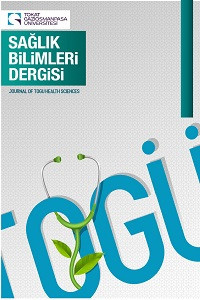Diyabet Bilgi Düzeyinin Artırılmasında Kavram Haritası ile Geleneksel Anlatıma Dayalı Öğretim Yönteminin Karşılaştırılması
Teaching methods, Traditional method, Concept map, Nursing education
Concept Map and Traditional Lecture-Based Teaching Method in Increasıng The Diabetes Knowledge Level
Nursing education, Teaching methods, concepts math,
___
- 1. Harrison CV. Predicting success for associate degree nursing students in a concept- based curriculum. Teach Learn Nurs 2018; 13: 135–140. https://doi.org/10.1016/j.teln.2018.01.005.
- 2. Kaddoura M, VanDyke O, Cheng B, Shea-Foisy. Impact of concept mapping on the development of clinical judgment skills in nursing students. Teach Learn Nurs 2016; 11: 101–107. http://dx.doi.org/10.1016/j.teln.2016.02.001.
- 3. Yue M, Zhang M, Zhang C, Jin C. The effectiveness of concept mapping on development of critical thinking in nursing education: A systematic review and meta- analysis. Nurse Educ Today 2017; 52: 87–94. http://dx.doi.org/10.1016/j.nedt.2017.02.018.
- 4. Aliyari S, Pishgooie AH, Abdi A, Mazhari MS, Nazari MR. Comparing two teaching methods based on concept map and lecture on the level of learning in basic life support. Nurse Educ Pract 2019; 38: 40–44. https://doi.org/10.1016/j.nepr.2019.05.008.
- 5. Lucieer SM, van der Geest JN, Elo´i-Santos SM, de Faria RMD, Jonker L, Visscher C, Rikers RMJP, Themmen APN. The development of self- regulated learning during the pre-clinical stage of medical school: a comparison between a lecture-based and a problembased curriculum. Adv in Health Sci Educ 2016; 21: 93–104. DOI:10.1007/s10459-015-9613-1
- 6. Jaafarpour M, Aazami S, Mozafari M. Does concept mapping enhance learning outcome of nursing students? Nurse Educ Today 2016; 36: 129–132. http://dx.doi.org/10.1016/j.nedt.2015.08.029.
- 7. Aghakhani N, Nia HS, Eghtedar S, Torabizadeh C. The Effect of Concept Mapping on the Learning Levels of Students in Taking the Course of “Nursing Care of Patients With Glandular Diseases Subject”; in Urmia University of Medical Sciences, Iran. Jundishapur J Chronic Dis Care 2015; 4 (2): e28387. DOI: 10.5812/jjcdc.28387.
- 8. Chan ZCY. A qualitative study on using concept maps in problem-based learning. Nurse Educ Pract 2017; 24: 70-76. https://doi.org/10.1016/j.nepr.2017.04.008.
- 9. Hsu LL, Pan HC, Hsieh SI. Randomized comparison between objective- based lectures and outcome-based concept mapping for teaching neurological care to nursing students. Nurse Educ Today 2016; 37: 83–90. http://dx.doi.org/10.1016/j.nedt.2015.11.032.
- 10. Tiap OS, Hassan H, Tee MH, Mohd Rosli RA. Evaluation of Clinical Learning Experience on Concept Mapping for Final Year Nursing Students in a Private Hospital. J Nurs Care 2018; 7(4): 2-5. doi:10.4172/2167-1168.1000465.
- 11. Zadeh NR, Gandomani HS, Delaram M, Yekta ZP. Comparing the Effect of Concept Mapping and Conventional Methods on Nursing Students’ Practical Skill Score. Nurs Midwifery Stud. 2015; 4(3): e27471. DOI: 10.17795/nmsjournal27471.
- 12. Garwood JK, Ahmed AH, McComb SA. The Effect of Concept Maps on Undergraduate Nursing Students’ Critical Thinking. Nurs Educ Perspect 2018; 39 (4): 208-214. doi: 10.1097/01.NEP.0000000000000307
- 13. Khrais H, Saleh AM. The Effect of Concept Mapping on Critical Thinking of Jordanian Nursing Students. Creat Nurs. 2020; 26(1): 19-24. doi: 10.1891/1078- 4535.26.1.e19.
- 14. Tunam A. The Learning and Satisfaction Levels of Nursing Students in Relation to Concept Maps and Video Recording. İTOBİAD 2017; 6 (3): 1863-75.
- 15. Sarıca R, Çetin B. The Effects of Using Concept Maps on Achievement and Retention in Teaching Science Lessons. EEO 2012;11(2): 306-318.
- 16. Dong R, Yang X, Xing B, Ziha Zou Z, Zhenda Zheng Z, Xie X, Zhu J, Chen L, Zhou H. Use of concept maps to promote electrocardiogram diagnosis learning in undergraduate medical students. Int J Clin Exp Med 2015; 8(5): 7794-7801. www.ijcem.com/ISSN:1940-5901/IJCEM0006251.
- 17. Karadakovan A. Sinir sitemi hastalıkları. Eds. Karadakovan, A. Eti, Arslan, F. Care in Internal and Surgical Diseases. 1st Edition. Adana, Nobel Bookstore, 2011; p.1203-7.
- 18. Erol Ö. Endocrine System Diseases and Care. Ed. Durna Z. Internal Medicine Nursing. 1 st Edition. İstanbul, Academy Press and Publishing, 2013; p.231-53.
- 19. Dörttepe ZÜ, Arikan B. Use of concept maps in nursing education. HEAD 2019; 16(2): 160-165. doi:10.5222/HEAD.2019.160
- 20. Aein F, Aliakbari F. Effectiveness of concept mapping and traditional linear nursing care plans on critical thinking skills in clinical pediatric nursing course. JEHP 2017; 6: 1-12. https://doi.org/10.4103/jehp.jehp_49_14
- 21. Dil S, Öz F. A teaching strategy in nursing: Using concept mapping. Journal of Hacettepe University Faculty of Nursing 2014; 1(1): 81-9. http://www.hacettepehemsirelikdergisi.org/pdf/pdf_HHD_154.pdf
- Yayın Aralığı: Yılda 3 Sayı
- Başlangıç: 2021
- Yayıncı: Tokat Gaziosmanpaşa Üniversitesi
Üniversite öğrencilerinin ruh sağlığı okuryazarlık düzeyi: kesitsel bir çalışma
Bediye ÖZTAŞ, Nursemin ÜNAL, Zeynep ÖLÇER, Ayşe ÇAL, Günay HAZİR
Evde Sağlık Hizmeti Alan Hastaların Acil Servise Başvuru Nedenlerinin İncelenmesi
Fatih OKAN, Sümeyye KAVİCİ PORSUK, Sedanur OĞUZ, Ayşenur ŞENGÜL, Ferhat ÖZBEN
Göçün Halk Sağlığı Sorunu Olarak Ruh Sağlığı Açısından Değerlendirilmesi
Özden TANDOĞAN, Meltem MECDİ KAYDIRAK, Bahar DOĞAN
Çocuğun Kanser Olmasının Aile Üzerindeki Etkisi: Anne-Baba Bakış Açısıyla
Didem COŞKUN ŞİMŞEK, Ulviye GÜNAY
Pandemi Sürecinde Gebelerin, COVİD 19 Bilgi Düzeyleri İle Koronavirüs Anksiyetesi Arasındaki İlişki
Ebru SADIÇ, Zümrüt YILAR ERKEK, Ülkem ŞEN UZELİ
Tüberküloz ile Mücadelede Covıd-19’un Etkisi
Geriatrik Onkoloji Hastalarında Kötü Prognoz Etkeni: Polifarmasi ve Yönetimi
